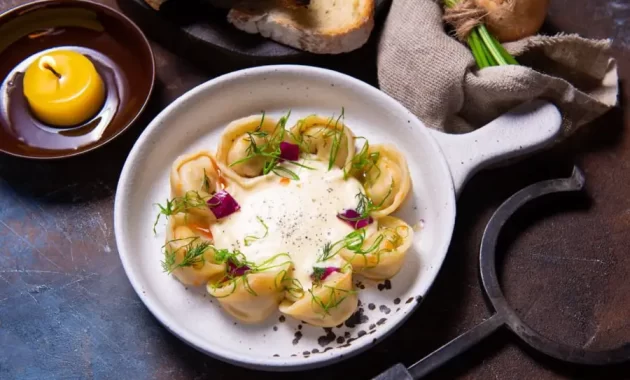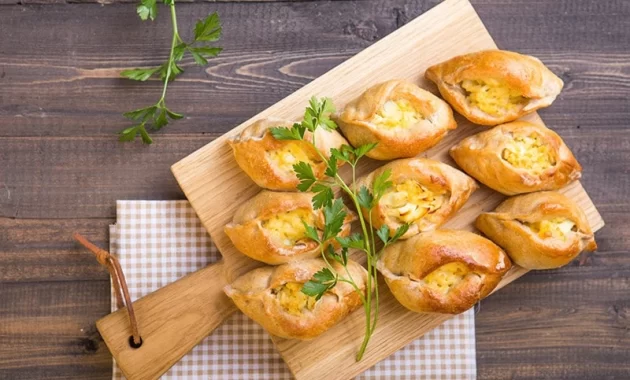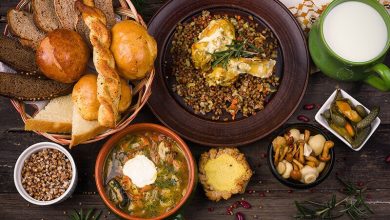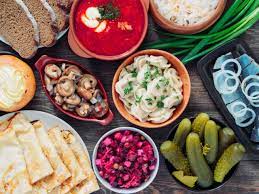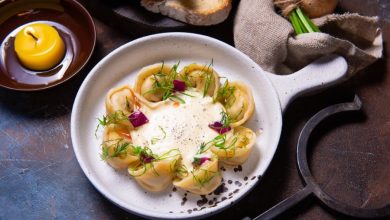RUSSIAN CUISINE – TOP 10 MOST POPULAR
In the photo: Olivier pizza (a dish from the seasonal New Year’s menu) from the Dodo Pizza pizzeria network – on a thick dough, ingredients: chicken, potatoes, green peas, carrots, ham, pickled cucumbers.
Russian salad.
Today, one of the most popular dishes not only in Russian, but also in many other cuisines around the world. The author’s dish of the legendary chef Lucien Olivier subsequently acquired so many new ideas, formats, recipes and servings – that it was published.
published and will be published in separate collections of recipes and cookbooks. You can find out about the 10 most popular Olivier varieties abroad here. Your family archive/restaurant/hotel has its own interesting recipe for Russian Salad — write to us and we will definitely try to tell our readers about it.
On the territory of our country, the dish became widespread in the 9th century (as a ritual treat during the Maslenitsa period). Popular traditional servings: with sour cream, mushrooms, meat, caviar, fish, cottage cheese, honey, jam, a stack or a neatly folded triangle.
Porridge.
“Our everything” of Russian cuisine is simple (given that the traditional heating in the country is a brick wood-burning stove, the heat from which is reasonable to use for cooking at the same time), understandable, functional format. Not only the most popular type of breakfast.
but also a side dish for lunch and dinner, but also the basis of a healthy diet in the region. The mention of the dish in written sources dates back to the 12th century, however, some archaeological finds confirm the use of porridge in Rus’ – at least from the 10th century. The most ancient species are spelled, lentils, barley.
Shchi. I
n the language of a technologist, a multi-component dressing soup. Traditionally the most beloved in the country. Still: hearty, simple and healthy, the basis is fresh or sauerkraut (subject to fermentation) cabbage.
Borsch.
Hot soup of characteristic red color based on beets. By the way, not necessarily raw (as is most often cooked today). Dahl’s Dictionary: “Rod of cabbage soup, sauerkraut stew, on beef and pork, or with lard.” Today, one of the most popular dishes of many world cuisines, with hundreds and thousands of different national, regional, family and author’s servings and recipes. The most popular traditional serving of borsch: with Borodino bread, lard and garlic.
Ear.
A traditional clear Russian soup made from several types of fish and three types of vegetables: potatoes, carrots and onions. By the way, Antoine Karem, nicknamed “the chef of kings and the king of chefs” called this particular dish “the most national Russian soup.”
Classic serving: with kulebyaka or pie. The optimal ingredients for fish soup are the presence of freshly caught fish, nature, a reservoir during cooking, as well as a glass of vodka (not in itself, but in a boiling saucepan immediately before serving).
Jelly.
A traditional Russian harbinger of the era of molecular cuisine. Hearty, usually festive (due to the long preparation), jelly-like, cold dish based on a rich broth of pork, beef (ears, tails, legs, heads with meat added) and / or poultry. It is known that Peter I considered jelly to be one of his favorite dishes and preferred it as the first lunch serving (“starter”), accompanied by pickles and sauerkraut.
Dumplings.
Perhaps the most controversial dish of Russian cuisine. It is clear that the idea of wrapping the main product in dough came to the mind of the Chinese. Like many, many other world culinary technologies. However, the difference between our dumplings and dim sums – in traditions, tastes, ideas, serving – is obvious after the first comparative tasting.
Okroshka,
cold, atmospheric, summer, once a peasant soup based on boiled potatoes, chicken eggs, meat (or sausage), kefir or kvass. Interestingly, the French disrespectfully nicknamed the last drink “lemonade de cochon” (“lemonade for pigs”).
Which, of course, speaks exclusively of the limited taste and mental abilities of the “critics”. Okroshka is a real masterpiece of all times and peoples! From which, by the way, many modern world cold soups were subsequently borrowed. And the first recipes of primordially Russian okroshka date back to the 9th-10th centuries.
Pies.
Another culinary visiting card of Russia, easily recognizable – regardless of geography. Traditional, popular toppings: meat, fish, mushrooms, potatoes, cabbage and, of course, jam.
On the opening photo: the author’s gastronomic set of Russian cuisine by Artur Ovchinnikov at the international culinary competition Bocuse d’Or, Lyon, France. Ingredients: calf thyroid gland, duck, seasonal forest wild asparagus, fresh moss, wild garlic flowers, purple carrots, kohlrabi.
